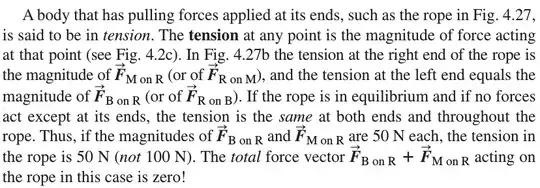I am afraid that I do not have access to the textbook.
Imagine a horizontal rope on a frictionless surface under tension.
If the rope was cut at any point it would separate with an end on the left $L$ and an end on the right $R$.
To prevent the separation suppose that external forces were applied to the rope at each of the ends, $\vec F_{\text{External on Rope L}}$ on the left hand end of the rope and $\vec F_{\text{External on Rope R}}$ on the right hand end of the rope.
Newton's third law tells you that the rope would be exerting forces on whatever is producing these external forces
$\vec F_{\text{Rope L on External}} = -\vec F_{\text{External on Rope L}}$
$\vec F_{\text{Rope R on External}} = -\vec F_{\text{External on Rope R}}$.
The magnitudes of all these forces are the same and so when the rope was whole before it was cut one can say the force on the left hand part of the rope due to the right hand part of the rope was equal in magnitude and opposite in direction to force on the right hand part of the rope due to the left hand part of the rope and these are the forces that are called the tension.
Tension only seems to reveal itself when you have an end to the rope because otherwise you have a static equilibrium situation at each position along the rope the net force is zero.
Now suppose that the rope has a mass and it is used to suspend a mass of weight $W$ from a fixed support and the whole system (weight, rope and support) is in static equilibrium.
At the point of contact between the rope and the mass the downward weight of the mass is equal to the upward force on the mass due to the rope which is called the tension in the rope.
A similar analysis will equate force at the top of the rope but this time the downward force on the support due to the rope, the tension in the rope, will be larger than at the bottom of the rope, because the upward force on the rope due to the support has to balance the weight of the mass at the end of the rope and the weight of the rope.
Now choose a segment of the rope.
The upward force on the top of the segment due to the tension in the rope above the segment will be larger than the downward force on the bottom of the segment due to the tension in the rope below the segment.
This is because the difference in these two tensions must equal the weight of the segment.
So in this situation the tension in the rope is not constant.
We now come to an example of simplification in terms of what one has to write which can cause a conceptual problem.
At each point along the rope the upward tension due to the rope above the point has to be equal in magnitude but opposite in direction to the weight of the rope and the mass hanging from it.
The simplification which is often made is to assume that the weight of the mass is much greater than the weight of the rope and this leads to the fact that the tension in the rope is approximately equal to the weight of the mass at the end of the rope and so the tension is approximately constant along the rope.
The shorthand version of this statement is say that the rope is massless.
You can think of a massless rope as transferring a force from one place to another and with the help of a pulley enabling the force to change direction.
